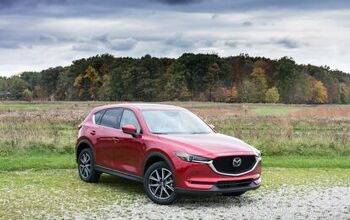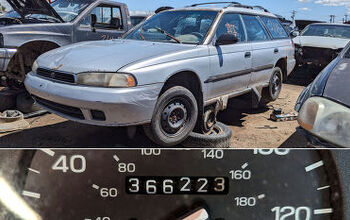Is the Mazda CX-5 About to Go Turbocharged?

Where would Mazda be without the hot-selling CX-5? Of the 29,980 vehicles Mazda sold in the U.S. last month, 47.3 percent of them were CX-5s. Suffice it to say the stylish compact crossover is the brand’s most important model, regardless of what MX-5 fans would have you believe.
Parents everywhere applauded when a crisper, better-handling CX-5 appeared for 2017, content in knowing a family vehicle existed that wouldn’t relegate them to a world of bland conformity. Our own Chris Tonn was enraptured by the sight of his Grand Touring tester as it sat in an Ohio parking lot. Still, despite its on-road prowess, the zoom-zoom brand’s most popular offering isn’t exactly a pavement scorcher. That might not be the case for long.
According to a certification document from the California Air Resources Board (CARB), Mazda might offer the 2019 CX-5 with the turbocharged 2.5-liter four-cylinder found in its larger CX-9 sibling. The doc shows emissions results from a 2.5-liter four boasting direct injection and forced induction, with its applications listed as the 2019 CX-5 and CX-9.
In the 2018 CX-9, this engine generates 227 horsepower and 310 lb-ft of torque. Currently, CX-5 buyers choose from a 2.0-liter Skyactiv four-cylinder making 156 hp and 150 lb-ft, or a naturally aspirated 2.5-liter with 187 hp and 186 lb-ft. A delayed diesel’s on the way. Should Mazda grace us with a hot rod variant of its compact ute, buyers can expect a two-thirds increase in twist compared to the existing top-line powerplant.
Maybe it’s too much to ask that it come with a stick shift.
Of course, Mazda doesn’t make a habit of commenting on future products, and this case is no exception. We’re left to wait and see if our crossover dreams come true.
Sales of the CX-5 in America haven’t waned once during its time on the market. Each year since its 2012 debut saw more and more buyers line up at their local dealer, ready to fill Mazda’s coffers. This May saw the crossover’s sales rise 19.9 percent, year over year, with volume over the first five months of 2018 up a generous 43.7 percent.
H/T to Bozi Tatarevic!
[Images: Mazda, CARB]

More by Steph Willems
Latest Car Reviews
Read moreLatest Product Reviews
Read moreRecent Comments
- Jeff One less option will be available for an affordable midsize sedan. Not much can be done about GM discontinuing the Malibu. GM, Ford, and Stellantis have been discontinuing cars for the most part to focus on pickups, crossovers, and suvs. Many buyers that don't want trucks or truck like vehicles have moved onto Japanese and South Korean brands. Meanwhile large pickups and suvs continue to pile up on dealer lots with some dealers still adding market adjustments to the stickers. Even Toyota dealers have growing inventories of Tundras and Tacomas.
- Lorenzo This car would have sold better if there was a kit to put fiberglass toast slices on the roof.
- Lorenzo The Malibu is close to what the 1955 Bel Air was, but 6 inches shorter in height, and 3 inches shorter in wheelbase, the former making it much more difficult to get into or out of. Grandma has to sit in front (groan) and she'll still have trouble getting in and out.The '55s had long options lists, but didn't include a 91 cubic inch four with a turbo, or a continuously variable transmission. Metal and decent fabric were replaced by cheap plastic too. The 1955 price was $1765 base, or $20,600 adjusted for inflation, but could be optioned up to $3,000 +/-, or $36,000, so in the same ballpark.The fuel economy, handling, and reliability are improved, but that's about it. Other than the fact that it means one fewer sedan available, there's no reason to be sorry it's being discontinued. Put the 1955 body on it and it'll sell like hotcakes, though.
- Calrson Fan We are already seeing multiple manufacturers steering away from EVs to Hybrids & PHEVs. Suspect the market will follow. Battery tech isn't anywhere close to where it needs to be for EV's to replace ICE's. Neither is the electrical grid or charging infrastructure. PHEV's still have the drawback that if you can't charge at home your not a potential customer. I've heard stories of people with Volts that never charge them but that's a unique kind of stupidity. If you can't or don't want to charge your PHEV then just get a hybrid.
- AZFelix The last time I missed the Malibu was when one swerved into my lane and I had to brake hard to avoid a collision. 1 out of 5⭐️. Do not recommend.




































Comments
Join the conversation
Would love to see this engine in a new MS3, but it seems Mazda has batten down the hatches to run a skeleton fleet. Still a little bummed nobody in the mainstream realm seems to be using hybrid tech to boost performance. Slap a 1kWh battery + 100kW motor in pretty much anything and you will have something interesting.
I said it a year ago. The 2.5T was not a good choice for the Mazda6 due to it's torque rich nature and lack of top end. Performance sedan owners want to wind out gears, have linear power delivery, and this engine was never designed for that application. I applaud Mazda for making this engine available in the 6, but it was never intended to be a Speed6 equivalent (no matter what journalists/forum members/car people said). But it will prove beneficial for golf foursomes who have had a few too many burgers at the local club, not for owners looking for a cheaper M3. Having driven it, the 2.5T is superb in the CX-9 because it operates where 90% of all drivers will play... below 5000 RPM. The power delivery of the 2.5T is superior to the 3.5 V6's of the competitor cars because it will help get the beast rolling when loaded down with the 6 passengers, or all the gear. The driver won't need to wind out the motor to make sufficient power when burdened down. As far as the CX-5? Yee-HAW!! For the same reasons of the CX-9 above, this will be a great motor in a great little car. Although sporty, I never got the desire to drive the CX-5/9 like I do my Mazdaspeed6. The power is there for passing, and when loaded down, and under normal circumstances, the engine will fade into the background like it should. In typical TTAC fashion, I can't wait to snag one of these up off lease in 2 years after a heck of a depreciation.